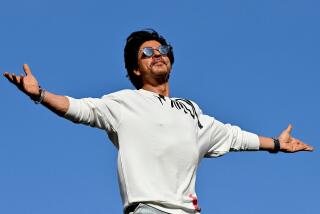Tuning In The Global Village : Frontier: India : ‘Dish Wallahs’ Plug India Into the World : Unregulated and growing fast, these entrepreneurs and their satellite TV have fostered a revolution.
- Share via
BOMBAY, India — From a tiny wooden shack atop an apartment building here, Yogesh Shah has helped start a communications revolution in India.
Shah is a “dish wallah,” one of thousands of small entrepreneurs who have brought satellite television to the world’s second most populous country. Thanks to businessmen like him, India has been transformed virtually overnight from an isolated country fed a diet of boring government documentaries to a full-fledged member of the global village, plugged into everything from 24-hour news to rock videos on MTV.
What’s more remarkable is that the revolution has taken place largely outside the law, free of India’s notorious bureaucracy and red tape. Unhindered by state controls, television in India has become a market commodity like soap powder or rice, and businesses are springing up at a dizzying rate to meet the demand.
The revolution had its roots in Bombay for three reasons: Historically, “Bollywood,” as the city became known, was the film production center of the country; English is widely spoken here, and the city is one of the most densely populated in the subcontinent, with a large number of high-rise apartment buildings.
The Indian government television network, known as Doordashan, which operates one channel in most cities, encouraged the revolution indirectly; Doordashan is a classic example of entertainment decreed by government committee, bland at best and boring at its frequent worst.
“The Indian population is literally starved for entertainment” said Ramana Prasad, a television manufacturer.
In the early 1980s, Shah and a handful of other businessmen were earning a modest living renting out videocassettes of Indian and Western movies. But they had a problem: At 300,000 rupees or so, the cost of a video player is more than a year’s average pay in poverty-ridden India, so their market was limited.
The entrepreneurs hit on the idea of wiring apartment buildings to a single video player--a kind of in-house cable system. They put a VCR in a basement or on the roof and showed movies all day long. Residents gave up individual choice in exchange for huge savings.
These rudimentary cable TV systems began popping up like mushrooms throughout Bombay and the rest of India. Before long, coaxial cable was leaping from roof to roof of apartment buildings as cable operators serviced more and more buildings from a single player. The government, with only an outdated 19th-Century Telegraph Act on the books, never bothered to regulate the business.
There were just 150 cable operators in 1985 in all of India. The number is now closer to 10,000.
Just as the Persian Gulf War changed television viewing habits in the United States, it created an almost insatiable demand for news in India. Yogesh Shah, in the up-market Walkeshwar neighborhood here, was the first operator to buy a satellite dish capable of receiving CNN. He hooked it up to his cable system, charging each of his 3,500 customers 600 rupees--about $20--for installation and 150 rupees, or $5, a month.
In May, 1991, the assassination of Prime Minister Rajiv Gandhi dramatically highlighted Doordashan’s shortcomings. Government television waited 12 hours to broadcast news of the assassination, while CNN carried the news almost instantaneously. Demand for satellite dishes boomed.
Then in August, 1991, Hong Kong-based Star Television provided a significant boost to satellite growth when it began broadcasting five channels accessible to a huge area of Asia stretching from Israel to Taiwan.
Programming included one channel of news from the British Broadcasting Corp., a sports channel, MTV and a channel showing conventional TV shows, all broadcasting in English. The fifth channel broadcasts exclusively in Mandarin Chinese.
“India was a real surprise to us,” said Arnold Tucker, executive vice president of Star TV. “After six months, it was our largest market.”
Almost overnight, Indian cable operators had reoriented their satellite dishes to capture the Star TV channels, rather than CNN.
“The audience is just waking up here,” said Amit Khanna, a television producer in Bombay. “In the next two years, we’ll see the first generation of couch potatoes in India.”
Katy Merchant, a vice president of the Indian Market Research Bureau, said the satellite market in India is growing at an astonishing rate, with the number of homes receiving satellite doubling or tripling every six months.
According to Star, the number of homes capable of receiving its service in India grew from 412,500 in January, 1992, to 1.28 million in June, an increase of 211%. By its estimate, Star now reaches 11.45% of households in India’s large towns.
The numbers are important because Star makes its money by selling advertising based on number of viewers. An average spot costs around $800 for 30 seconds.
Earlier this year, when Star aired the World Cup of cricket, a sport popular in former British colonies, sales of dishes in India skyrocketed. Nowadays, the most popular TV program in India is the American soap opera “Santa Barbara.”
The advent of cable TV has had a distinct impact on society in India. There is now daytime television for the first time, and prime-time evening shows are attracting new viewers.
“Cable has killed the cinema theater industry,” Merchant said.
MTV has created a demand for Western rock music almost from scratch.
“Sales of Western music have doubled since MTV went on the air,” said Vincent Longobardo, executive producer for MTV in Hong Kong. “We’re having a tremendous impact on fashions. . . .” Young women are copying haircuts seen on MTV. Designers are copying clothes.
Because the subcontinent is far more conservative than Europe or the United States, Star tailors programming to avoid offending viewers--not showing, for instance, Madonna’s latest R-rated video, “Erotica.”
“We tend to be non-controversial,” said Star’s Tucker. Still, Star’s programming is likely to accelerate an already vocal debate about the importation of Western values into countries of the Indian subcontinent.
Since Star is a private company, it does not disclose its finances. Tucker said that while still not profitable, the company is meeting its advertising goals well ahead of schedule.
While Star has captured the lion’s share of the audience--up to 60% by its own estimates--business people in India note that Star is limited to English-speaking households, and more than 80% of India’s 800 million people don’t speak English.
Sensing a lucrative untapped market for Hindi-language entertainment, two new companies have recently started up. A company called Asia Television Network began satellite broadcasts Aug. 15, and another firm, Zee Television, rented a channel from Star TV and began Hindi broadcasts Oct. 1.
“A year ago, CNN controlled 100% of the Indian (satellite) market,” said Amit Dev, vice president of ATN. “Now Star controls 95%. Maybe the future belongs to us.”
Not content to be left entirely out of the communications revolution, Doordashan has announced plans to create a second Hindi channel in its major markets to compete with satellite broadcasters. Private TV producers admit it could become a potent rival if it is well managed.
The Indian government has also indicated it is not happy with unregulated cable activity. A government statement said it plans to introduce legislation to establish cable franchises for major cities by early next year. But by then, many operators believe, the industry will be too big to stop.
More to Read
Sign up for Essential California
The most important California stories and recommendations in your inbox every morning.
You may occasionally receive promotional content from the Los Angeles Times.










